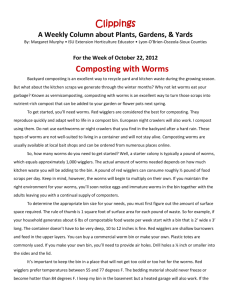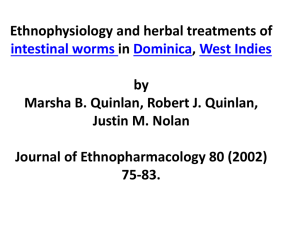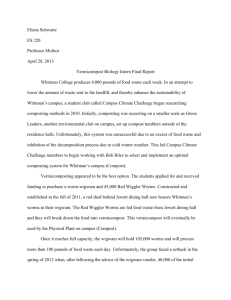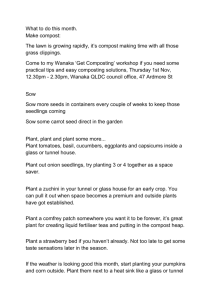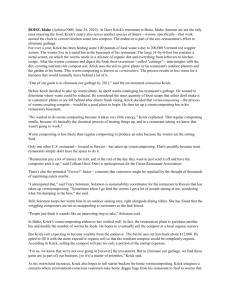Why Compost With Worms?
advertisement
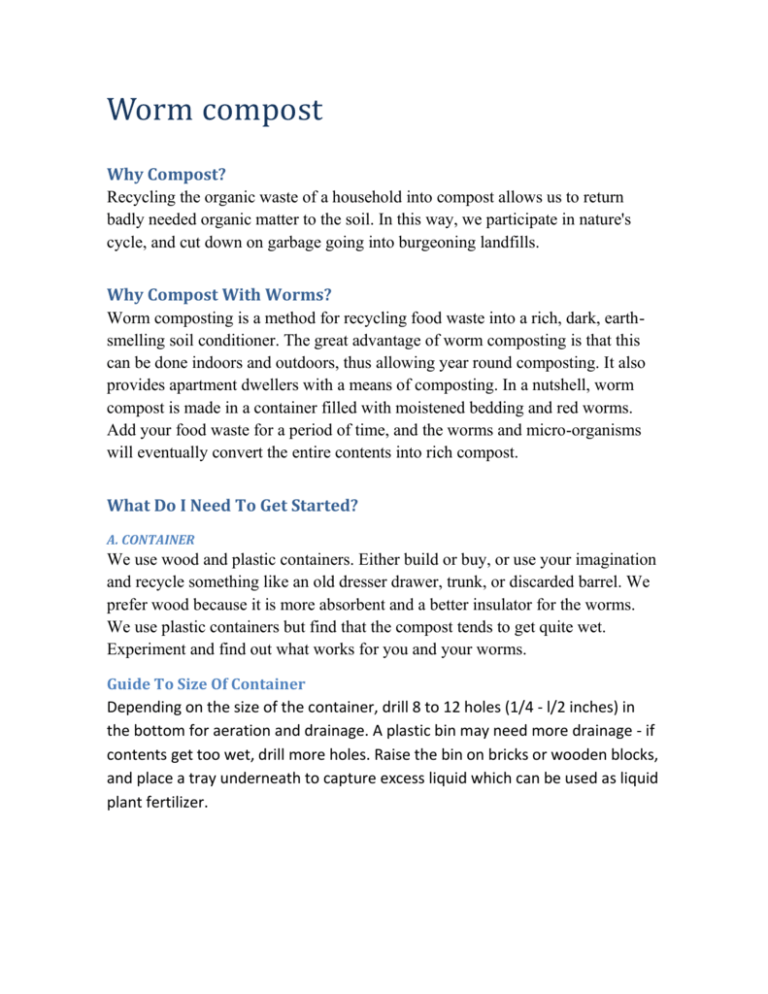
Worm compost Why Compost? Recycling the organic waste of a household into compost allows us to return badly needed organic matter to the soil. In this way, we participate in nature's cycle, and cut down on garbage going into burgeoning landfills. Why Compost With Worms? Worm composting is a method for recycling food waste into a rich, dark, earthsmelling soil conditioner. The great advantage of worm composting is that this can be done indoors and outdoors, thus allowing year round composting. It also provides apartment dwellers with a means of composting. In a nutshell, worm compost is made in a container filled with moistened bedding and red worms. Add your food waste for a period of time, and the worms and micro-organisms will eventually convert the entire contents into rich compost. What Do I Need To Get Started? A. CONTAINER We use wood and plastic containers. Either build or buy, or use your imagination and recycle something like an old dresser drawer, trunk, or discarded barrel. We prefer wood because it is more absorbent and a better insulator for the worms. We use plastic containers but find that the compost tends to get quite wet. Experiment and find out what works for you and your worms. Guide To Size Of Container Depending on the size of the container, drill 8 to 12 holes (1/4 - l/2 inches) in the bottom for aeration and drainage. A plastic bin may need more drainage - if contents get too wet, drill more holes. Raise the bin on bricks or wooden blocks, and place a tray underneath to capture excess liquid which can be used as liquid plant fertilizer. B. BEDDING It is necessary to provide a damp bedding for the worms to live in, and to bury food waste in. Suitable bedding materials are shredded newspaper and cardboard, shredded fall leaves, chopped up straw and other dead plants, seaweed, sawdust, compost and aged manure. Try to vary the bedding in the bin as much as possible, to provide more nutrients for the worms, and to create a richer compost. Add a couple of handfuls of sand or soil to provide necessary grit for the worm's digestion of food. It is very important to moisten the dry bedding materials before putting them in the bin, so that the overall moisture level is like a wrung-out sponge. The bin should be about three-quarters full of moistened bedding. Lift the bedding gently to create air spaces which help to control odours, and give freer movement to the worms. C. WORMS The two types of earthworm best suited to worm composting are the red worms: Eisenia foetida (commonly known as red wiggler, brandling, or manure worm) and Lumbricus rubellus They are often found in aged manure and compost heaps. Please do not use dewworms (large size worms found in soil and compost) as they are not likely to survive. Where To Get Your Worms? If you feel adventurous, find a horse stable or farmer with a manure pile and collect a bagful of manure with worms. Check your own or a friend's compost bin for worms. You can also purchase worms. Call the Compost Hotline for more details on local (British Columbia) sources of red worms. How Many Worms Do I Need? Mary Appelhof suggests that the correct ratio of worms to food waste should be: for one pound per day of food waste, use two pounds of worms (roughly 2000). If you are unable to get this many worms to start with, reduce the amount of food waste accordingly while the population steadily increases. What Do I Feed My Worms? You can compost food scraps such as fruit and vegetable peels, pulverized egg shells, tea bags and coffee grounds. It is advisable not to compost meats, dairy products, oily foods, and grains because of problems with smells, flies, and rodents. No glass. plastic or tin foil, please. To avoid fly and smell problems, always bury the food waste by pulling aside some of the bedding, dumping the waste, and then cover it up with the bedding again. Bury successive loads in different locations in the bin. By Gillian Elcock and Josie Martens (C) Copyright: City Farmer 1995 http://www.cityfarmer.org/wormcomp61.html





